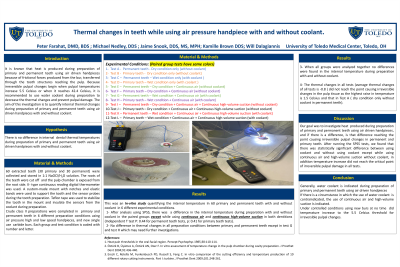Restorative
533 - Thermal Changes Using Air Pressure Handpiece With and Without Coolant


Peter M. Farahat, D.M.D
Pediatric dental resident
The University of Toledo Medical Center, Toledo, OH
University of Toledo
Perrysburg, Ohio, United States- KB
Kamille Brown, D.D.S
University of Toledo Medical center
- WD
Will Dalagiannis, Student
University of Toledo
- JS
Jaime Snook, D.D.S
University of Toledo Medical Center
- MN
Michael P. Nedley, D.D.S
Program Director
The University of Toledo Medical Center
Toledo, Ohio, United States
Presenting Author(s)
Co-Author(s)
Program Director(s)
Purpose: To quantify internal thermal changes during preparation of primary and permanent teeth using air driven handpieces with and without coolant.
Methods: Sixty extracted teeth (30 primary and 30 permanent) were collected and stored in NaOCl/H2O solution. The pulp chamber was exposed from the root side. K- type digital thermometer, custom-made mount, elastic bands, Teflon, new single use carbide burs were used. Crude class II preparations were completed in the teeth in 6 different preparation conditions using air driven high and low speed handpieces.
Results: After analysis using SPSS, there is a difference in the internal temperature during preparation with and without coolant except while using continuous air and high-volume suction in both dentitions. No difference in thermal changes in all conditions between both dentitions except in test G and test H. When all groups were analyzed together no differences were found in the internal temperature during preparation with and without coolant. The thermal changes in all tests did not reach the point (average thermal changes -0.8 Celsius) causing irreversible changes in the pulp tissue as the highest raise in temperature is 1.5 Celsius.
Conclusion: Water coolant is indicated during preparation of primary and permanent teeth using air driven handpieces. For circumstances in which the use of water coolant is contraindicated, the use of continuous air and high-volume suction is indicated. At no time did the temperature increase to the 5.5 Celsius threshold for irreversible pulpal changes.
Identify Supporting Agency and Grant Number: None

.jpg)